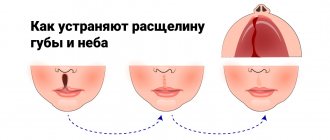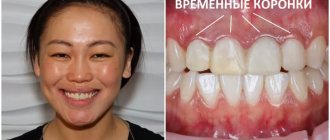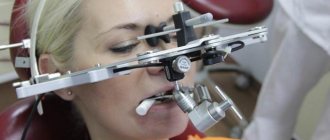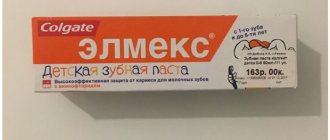Before the invention of anesthesia, about 70% of operations ended in the death of the patient; patient survival depended only on the speed of the surgeon’s work. In 1839, the French surgeon Velpeau stated that “the elimination of pain during operations is a chimera that cannot even be thought about; cutting instrument and pain are two concepts inseparable from each other in the mind of the patient.”
On March 30, 1842, the American doctor Crawford Long first gave a patient to breathe ether before surgery. He published his results only in 1849, and on October 16, 1846, a test of ether anesthesia took place in the USA.
In Russia, the first operation using ether anesthesia was performed by a doctor, doctor of medicine, surgeon Fyodor Inozemtsev . The operation took place on February 7, 1847 on the territory of the First City Hospital in Riga. , Nikolai Pirogov also used ether anesthesia .
Light seal: is it possible to smoke?
When can you eat after a light filling
? Can you smoke after a light filling?
Consequences of smoking after having a filling installed
Is it possible to smoke after a temporary filling?
Despite the fact that modern filling materials have excellent characteristics, the durability of the filling depends on the actions of the person himself. Of course, the doctor gives certain recommendations on what can and cannot be done immediately after dental treatment, but not everyone follows them. What consequences can this lead to and is it possible to smoke after a light filling?
How to prepare for surgery
Before any operation, excluding emergency cases, careful preparation is carried out: doctors, the attending surgeon and an anesthesiologist assess the patient’s health, conduct an examination and prescribe tests, including a general blood test, a blood clotting test, a general urinalysis, and an ECG.
Based on all procedures, the doctor assesses the patient’s readiness for anesthesia. The operation is postponed if the patient has ARVI, high fever, or exacerbation of a concomitant disease.
Article on the topic
7 common myths about anesthesia The absence of complications after anesthesia is determined by several factors - the patient’s health condition and the work of the anesthesiologist. Therefore, before anesthesia, it is important to properly prepare for the operation and take into account all the nuances, in particular:
- Choose a medical institution as carefully as possible, because the risk of side effects from the use of anesthesia is lower, the higher the qualifications of the anesthesiologist.
- Tell your doctor about all the medications you are taking—drugs when combined can change their activity and duration of action. For example, taking regular aspirin affects blood clotting; sleeping pills and sedatives can change the body's reaction to the administration of painkillers.
- Tell your doctor about all concomitant diseases. A contraindication to anesthesia is any acute illness, exacerbation of a chronic disease, or even the onset of menstruation.
- Do not eat or drink (even water) 6 hours before anesthesia. In consultation with your doctor, you can take sedatives at night and in the morning to get enough sleep and not worry too much. It is also necessary to avoid alcohol consumption.
- It is recommended to eliminate cigarette smoking from your life 6 weeks before surgery - this will reduce the risk of respiratory complications after surgery. Under no circumstances should you smoke on the day of surgery.
- Before the operation, it is necessary to remove all removable objects (dentures, piercings) from the oral cavity, as well as remove contact lenses and hearing aids.
- Remove nail polish from nails as it may interfere with the patient's breath analysis.
- Check with your doctor about what exactly you need to prepare for surgery. This usually concerns the preparation of the necessary clothing, personal hygiene products and items to fill the time free from treatment.
The doctor decides which type of anesthesia is right for you. Today, anesthesiologists use about a dozen drugs during surgery. Often, even for the same operation, but for different patients, different anesthesia is used. In emergency cases of anesthesia, the best type of “urgent” anesthesia is the one that the anesthesiologist uses daily and is the best at.
When can you eat after a light filling?
Today the most popular filling is light. Almost all dentists prefer it. On the first day after the procedure, the filling is extremely sensitive to any influences, since the material has not yet completely hardened. It is better to eat food after 1-2 hours, but it is undesirable to use foods and drinks containing dye, since the filling material easily absorbs coloring pigments.
What foods should be excluded on the first day after treatment:
- coffee, tea, red wine;
- beet;
- dark berries (blueberries, blueberries);
- various sauces.
Food should not be too hot or cold.
Why can't Botox and antibiotics be combined?
A very important aspect of preparing for botulinum therapy is the need to complete in advance (preferably at least 1 month) all medications that may affect the effect of Botox on muscle tissue. Antibiotics are also among these medications. In particular, you should limit the use of the following medications:
- tetracycline antibiotics - this group of drugs significantly reduces the effectiveness of botulinum toxin, which will not allow obtaining the desired aesthetic result;
- aminoglycoside antibiotics - these drugs, on the contrary, potentiate the effect of the drug, which can lead to such unexpected consequences of the procedure as drooping eyelids and changes in facial contour;
- erythromycin, lincomycin, macrolides, polymyxin - these antibiotics can disrupt the distribution of Botox in tissues, which sometimes causes unpredictable visual consequences;
- muscle relaxants - all medicinal substances that can affect muscle tissue are strictly contraindicated for at least two weeks after Botox injections due to the likely increase in effects;
- aspirin and all anticoagulants - agents that can reduce blood clotting significantly increase the likelihood of bruising and hematomas at the injection sites of Botox.
You should limit yourself from taking antibiotics after Botox injections for 10-14 days. If there is an urgent need for antibiotic therapy, you should definitely inform your doctor about your recent procedure, in order to select the safest combination of drugs.
Is it possible to smoke after a light filling?
Many owners of a bad habit immediately light a cigarette upon leaving the dentist. What consequences can this lead to? During treatment, for example, caries or periodontitis, the structure of the teeth is disrupted, and sometimes the mucous membrane can be injured. Tobacco smoke negatively affects the healing and enamel of teeth. In addition, nicotine, reacting with filling materials, negatively affects their properties. Therefore, after treatment, it is better to give up cigarettes for at least a couple of hours, or better yet, for a day. This will help the tissues recover faster and the filling to become stronger.
About the period after anesthesia
Common adverse reactions and complications after anesthesia:
- Pain
After the end of general anesthesia, you may feel pain in the surgical area. If upon arrival in the recovery room you still feel it, then inform the medical staff about this - you will be given painkillers.
- Nausea
This is a very common consequence of anesthesia, occurring in approximately 30% of cases. Nausea is more common with general than with regional anesthesia. Here are some tips to help reduce your risk of nausea:
- During the first hours after surgery, you should not be active - sit down and get out of bed;
- Avoid drinking water and food immediately after surgery;
- good pain relief is also important as severe pain can cause nausea, so if you experience pain, tell your healthcare team;
- Deep breathing with slow inhalation of air can reduce the feeling of nausea.
- A sore throat
The endotracheal tube at the stage of awakening from anesthesia can cause an unpleasant feeling of discomfort and sore throat. You need to take this calmly, try to breathe evenly and, most importantly, follow all the instructions of your anesthesiologist. Discomfort, dry mouth, and pain when speaking or swallowing may also be felt for several hours after surgery, but may persist for two or more days. If the above symptoms do not go away within two days after surgery, contact your doctor. A sore throat is only a consequence of anesthesia.
- Shiver
Trembling, as a consequence of anesthesia, is a fairly common problem, as it causes great discomfort, although most often it does not pose a danger to the body and lasts about 20-30 minutes. Trembling can occur after general anesthesia and can also occur after epidural and spinal anesthesia.
- Sensory impairment
During anesthesia, there is a lack of muscle tone, which may result in positional compression of the nerve, which can cause sensory disturbances at the site of compression that last for several weeks. After an operation performed under spinal or epidural anesthesia, the legs become numb for several hours, and emptying the bladder may also be difficult; if necessary, a urinary catheter is installed.
- Dizziness and lightheadedness
The residual effect of anesthetics may manifest itself in the form of a slight decrease in blood pressure, in addition, dehydration, which is not so uncommon after surgery, can lead to the same effect. A decrease in pressure can cause dizziness, weakness, and faintness.
- Headache
There are many reasons that can cause a headache. These include the medications used for anesthesia, the surgery itself, dehydration, and patient anxiety. Most often, the headache goes away within a few hours after anesthesia and can be easily controlled with painkillers. Severe headaches may be a complication of spinal or epidural anesthesia, and treatment may require bed rest for several days.
- Itching
This is usually an adverse reaction to anesthesia medications, but itching can also be an allergic reaction, so be sure to tell your doctor if it occurs.
- Back and lower back pain
During surgery, the patient lies in one constant position on a hard operating table for quite a long time, which can cause the back to become “tired” and ultimately lead to lower back pain after surgery.
- Muscle pain
These pains are most common in young males and are most often associated with the use of drugs to relax muscles during anesthesia. Muscle pain is a consequence of anesthesia (general anesthesia), it is symmetrical, most often localized in the neck, shoulders, upper abdomen and lasts approximately 2-3 days after surgery.
After surgery in the intensive care unit
Depending on the severity of the surgery, postoperative monitoring in the intensive care unit may be necessary. As needed, you will be prescribed medications, possibly in the form of injections/drips. Unfortunately, it is inevitable that the wound after surgery will hurt for some time. If you feel severe pain, you must immediately inform the staff so that the necessary measures can be taken.
Depending on the operation performed, you may have a gastric tube, drainage and a urinary catheter installed.
- Gastric tube
Probes are used to evacuate the contents of the gastrointestinal tract. This is a necessary measure and it is necessary to understand the importance of this procedure. A gastric tube helps you avoid vomiting in the postoperative period, because... all gastric contents will flow through it into a special container. You may experience discomfort and sore throat.
If necessary, enteral nutrition is provided through a tube, i.e. introduction of balanced mixtures to provide your body with nutrients and vitamins. In the first day (and in some cases longer) after the operation, you should not drink or eat. You will receive all the fluid your body needs through an intravenous infusion and tube.
- Drains
Drainage is a treatment method that involves removing discharge from wounds, natural, purulent and other pathological cavities, and the contents of hollow organs.
Drainage - rubber or plastic tubes of various diameters, thin rubber strips, dry aseptic swabs.
- Urinary catheter
If you are unable to urinate on your own, a urinary catheter may be inserted into your bladder to make urination easier.
(See About the Intensive Care Unit) (Active link)
The department team wishes you a speedy recovery!
Does nicotine interfere with the healing process?
I would like to immediately clarify that the healing process when removing a wisdom tooth and, for example, a mobile tooth, will vary in duration, you need to keep this in mind. As for smoking, I can say with full conviction that it is bad not only for a person’s lungs, but also for the body as a whole. Cigarette smoke does interfere with healing and can have a detrimental effect on your mouth after dental procedures.
First of all, the smoke enters the oral cavity, where the tar contained in the cigarette can settle, which can subsequently cause infection or, worse, introduce an infection into any open wound.
One of the most popular problems caused by smoking is yellowing of the teeth, tongue, gum disease and much more. Worth thinking about!










